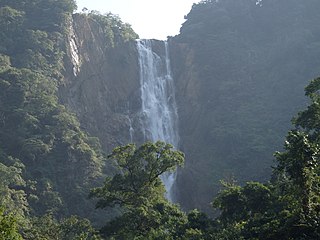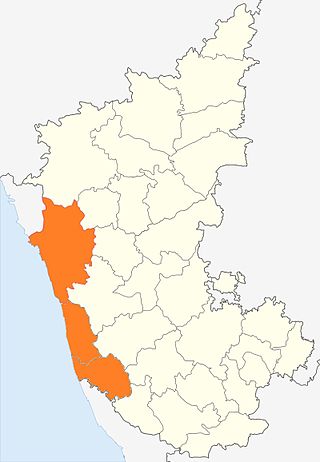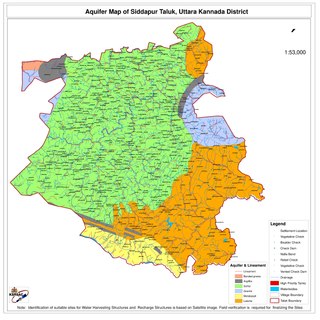
Tulu is a Dravidian language whose speakers are concentrated in Dakshina Kannada and in the southern part of Udupi of Karnataka in south-western India and also in the northern parts of the Kasaragod district of Kerala. The native speakers of Tulu are referred to as Tuluva or Tulu people and the geographical area is unofficially called Tulu Nadu.

Uttara Kannada is a district in the Indian state of Karnataka. It is a major coastal district of Karnataka, and is the third largest district in Karnataka. It is bordered by the state of Goa and Belagavi districts to the north, Dharwad District and Haveri District to the east, Shivamogga District, and Udupi District to the south, and the Laccadive Sea to the west.

Kanara or Canara, also known as Karavali is the historically significant stretch of land situated by the southwestern coast of India, alongside the Arabian Sea in the present-day Indian state of Karnataka. The subregion comprises three civil districts, namely: Uttara Kannada, Udupi, and Dakshina Kannada. Kassergode was included prior to the States Reorganisation Act.

Dakshina Kannada district is located in the state of Karnataka in India, with its headquarters in the coastal city of Mangalore. It is part of the larger Tulu Nadu region. The district covers an area nestled in between the Western Ghats to its east and the Arabian Sea to its west. Dakshina Kannada receives abundant rainfall during the Indian monsoon. It is bordered by Udupi district to the north, Chikmagalur district to the northeast, Hassan district to the east, Kodagu to the southeast and Kasaragod district of Kerala to the south. According to the 2011 census of India, Dakshina Kannada district had a population of 2,083,625. It is the only district in Karnataka state to have all modes of transport like road, rail, water and air due to the presence of a major hub, Mangalore. This financial district is also known as the Cradle of Indian banking.

Tulu Nadu or Tulunad is a region and a proposed state on the southwestern coast of India. The Tulu people, known as 'Tuluva', speakers of Tulu, a Dravidian language, are the preponderant ethnic group of this region. South Canara, an erstwhile district and a historical area, encompassing the undivided territory of the contemporary Dakshina Kannada and Udupi districts of Karnataka State and Kasaragod district of Kerala state forms the cultural area of the Tuluver.
Puttur (Pronunciation:) is a city in Dakshina Kannada district, in Karnataka state of India. The Puttur Shree Mahalingeshwara Temple is located here.
Hegde or Heggade Pergade is a common surname found primarily in the Kanara, Tulu Nadu and Konkan regions of India. It is prevalent among various Hindu communities in these regions, including the Kuruba Gowda, Bunt, Saraswat Brahmins, Kannada Jain, Havyaka Brahmin, and Vokkaliga communities of Karnataka.

Udupi district is an administrative subdivision in the Karnataka state of India, with the district headquarters in the city of Udupi. It is situated in the Canara old north malabar coastal region, there are seven taluks, 233 villages and 21 towns in Udupi district. The three northern tehsils of Udupi, Kundapur and Karkala, were partitioned from Dakshina Kannada district to form Udupi district on 25 August 1997. Moodabidri was officially declared as new tehsil (taluk), separated from Karkala with effect from 11 January 2018.
The Shivalli Brahmins are a Hindu Brahmin community in Karnataka. They are divided into two groups, the first of who follow the Dvaita philosophy founded by the Vaishnava saint Madhvacharya of Udupi are called Shivalli Madhva Brahmins, and the second of who follow the Advaita philosophy of Adi Shankara are known as Shivalli Smartha Brahmins. Majority of Shivalli Brahmins are Madhvas and only a few of them are Smarthas.
Udupi cuisine is a cuisine of South India. It forms an important part of Tuluva cuisine and takes its name from Udupi, a city on the southwest coast of India in the Tulunadu region of the state of Karnataka.

Sirsi is a city and a taluk headquarter in Uttara Kannada district of Karnataka state in India. It was also known as Kalyana Pattana during the Sonda Dynasty. It is a tourist destination with evergreen forest and waterfalls and is also a commercial centre. The main businesses around the city are mostly subsistence and agriculture-based. Areca nut or betel nut, locally known as Adike, is the primary crop grown in the nearby villages, making it one of the major trading centres for areca nut. The region is also known for spices such as cardamom, pepper, betel leaves, and vanilla. The major food crop is paddy.

Siddapur Taluk is the destination of world famous Jog Falls. It is a part of Uttara Kannada district, Karnataka, India and is located in the midst of forest areas of Western Ghats and it is also a part of Malenadu. The taluk is full of greenery, hills and arecanut gardens developed in the valleys’. The taluk headquarters is Siddapur. Sirsi is the nearest city,
Devadiga also known as Moily, Sherigar is a Hindu Community or Caste. Devadigas were traditionally temple servants and musicians in Hindu temples. Devadigas are originally from the land stretching between Karwar in Uttara Kannada district of Karnataka and Kasaragod district of Kerala and some parts of Maharashtra in west-coast of India up to the Chandragiri River and Many People live in Shivamogga and Chikmagalur too. Devadigas are quite distinct from the Ambalavasi(Semi-Brahmin)(temple servants) found elsewhere. It is believed that their two divisions, namely Kannada Devadiga (Moily) and Tulu Devadiga (Moily); were endogamous in the past.
Siddapura is a town and the headquarters of Siddapur taluk, It is located at a distance of 39 km (24 mi) from Sirsi through SH 93. it is part Uttara Kannada district in Karnataka. It is nestled among the Malenadu region. The town is surrounded by forests and lush greenery, and the region is popular for its many waterfalls.it is known for its proximity to Jog Falls, Adike is the primary crop grown in the villages that surround the town.
Konkani cuisine is the cuisine of the Saraswat Brahmins from the Konkan region on the western coast of India. Konkani cuisine differs within the Saraswat Brahmin subsects and within the Konkan-Canara region. Konkani cuisine originally hails from the Konkan region including Uttara Kannada, Udupi district, Dakshina Kannada, Damaon, and Goa, India. Konkani cuisine is popular served in many restaurants throughout the western coast of India, and especially in the cities of Bombay and Bangalore. Each variation has its unique flavour and makes uses of different vegetables and fruits available in the region. Konkani cuisine is usually pesco-vegetarian, except acharyas and purohits who follow a strictly saatvik vegetarian diet. According the Konkani folklore, fish, meats are regarded as sea vegetables. Historically, they have refrained from eating any terrestrial animals in general.
Sri Idagunji Mahaganapati Yakshagana Mandali, Keremane (R)(Kannada: ಇಡಗುಂಜಿ ಮಹಾಗಣಪತಿ ಯಕ್ಷಗಾನ ಮಂಡಳಿ)or simply the Keremane Yakshagana Troupe is a Yakshagana troupe based in the Uttara Kannada district of Karnataka, India. It was started by Keremane Shivarama Hegde in 1934. He is an exponent of this art form and is the first Yakshagana artist to win the Rashtrapati Award, an award handed out by the President of India to people who excel in various fields. The troupe has survived three generations, with his children Shambu Hegde, Mahabala Hegde and Gajanana Hegde and his grand son Shivananda Hegde also being exponents of Yakshagana. Keremane Shivananda Hegde is the current director of the troupe and the institution.
Karopady is a small village in Dakshina Kannada district, Karnataka, in far southern India. It is the border village between Karnataka and Kerala. Kasaragod District is the neighbouring district in Kerala State.
Havigannada, also called as Havyaka Bhaashe and Havyaka Kannada, is the dialect of Kannada spoken by Havyaka Brahmins in Malenadu and coastal region of Karnataka.

Tulu Nadu State movement is aimed at increasing Tulu Nadu's influence and political power through the formation of separate Tulu Nadu state from Karnataka and Kerala. Tulu Nadu is a region on the south-western coast of India. It consists of the Dakshina Kannada and Udupi districts of Karnataka and Kasargod district up to the Chandragiri river in Kerala. The Chandragiri River has traditionally been considered a boundary between Tulu Nadu and Kerala from the fourth century AD onwards. The first call for a separate Tulu Nadu state was made just after the Quit India Movement in 1942 by Srinivas Updhyaya Paniyadi, a banker and a press owner from Udupi. Mangalore is the largest and the chief city of Tulu Nadu. Tulu activists have been demanding a separate Tulu Nadu state since the late 2000s, considering language and culture as the basis for their demand.
Cukkemane or Kukkemane or Cuckemane is surname or a family name belonging to members of the Havyaka Brahmin Community. They belong to the Gautama gotra; they originate from and are mainly based in Kodagu (Coorg), Karnataka, a state in South India. They are from Kukke which was part of Amara Sulya district, formerly in the old kingdom of Kodagu.








